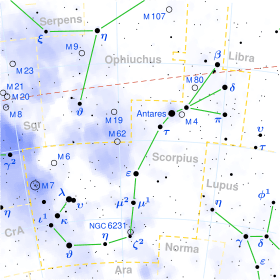Upsilon Scorpii
Upsilon Scorpii (υ Scorpii, abbreviated Upsilon Sco, υ Sco), formally named Lesath /ˈliːsæθ/,[9] is a star located in the "stinger" of the southern zodiac constellation of Scorpius, the scorpion. Based on parallax measurements obtained during the Hipparcos mission, it is approximately 580 light-years from the Sun.[1] In the night sky it lies near the 1.6 magnitude star Lambda Scorpii, and the two form an optical pair that is sometimes called the "Cat's Eyes".[10]
 | |
| Observation data Epoch J2000.0 Equinox J2000.0 | |
|---|---|
| Constellation | Scorpius |
| Right ascension | 17h 30m 45.83712s[1] |
| Declination | –37° 17′ 44.9285″[1] |
| Apparent magnitude (V) | 2.70[2] |
| Characteristics | |
| Spectral type | B2 IV[3] |
| U−B color index | –0.854[2] |
| B−V color index | –0.221[2] |
| Astrometry | |
| Radial velocity (Rv) | +8.0[4] km/s |
| Proper motion (μ) | RA: –2.37[1] mas/yr Dec.: 30.09[1] mas/yr |
| Parallax (π) | 5.66 ± 0.18[1] mas |
| Distance | 580 ± 20 ly (177 ± 6 pc) |
| Absolute magnitude (MV) | −3.53[5] |
| Details | |
| Mass | 11.4 ± 0.5[6] M☉ |
| Radius | 6.1[7] R☉ |
| Luminosity | 7381[5] L☉ |
| Temperature | 22,831 ± 169[7] K |
| Age | 20.0 ± 2.6[6] Myr |
| Other designations | |
| Database references | |
| SIMBAD | data |
Nomenclature
υ Scorpii (Latinised to Upsilon Scorpii) is the star's Bayer designation.
It bore the traditional name Lesath (alternatively spelled Leschath, Lesuth), from the Arabic las'a "pass (or bite) of a poisonous animal"; but this is a miscorrection by Scaliger (a European astronomer who knew Arabic) for earlier "Alascha", which came from Arabic al laţkha "the foggy patch", referring to the nearby open cluster M7. In 2016, the International Astronomical Union organized a Working Group on Star Names (WGSN)[11] to catalogue and standardize proper names for stars. The WGSN approved the name Lesath for this star on 21 August 2016 and it is now so included in the List of IAU-approved Star Names.[9]
Together with Lambda Scorpii (Shaula), Lesath is listed in the Babylonian compendium MUL.APIN as dSharur4 u dShargaz, meaning "Sharur and Shargaz".[12] In Coptic, they were called Minamref[13] The indigenous Boorong people of northwestern Victoria named it as Karik Karik (together with Lambda Scorpii),[14] "the Falcons"[15]
In Chinese, 尾宿 (Wěi Xiù), meaning Tail, refers to an asterism consisting of Upsilon, Mu1, Epsilon, Zeta1, Zeta2, Eta, Theta, Iota1, Iota2, Kappa, and Lambda Scorpii.[16] Consequently, the Chinese name for Upsilon Scorpii itself is 尾宿九 (Wěi Xiù jiǔ), "the Ninth Star of Tail".[17]
Namesake
USS Lesuth (AK-125) was a United States Navy Crater class cargo ship named after the star.
Properties
This star has apparent magnitude +2.7[2] and belongs to spectral class B2 IV,[3] with the luminosity class of 'IV' indicating it is a subgiant star. The star's luminosity is 12,300[18] times that of the Sun, while its surface temperature is 22,831[7] kelvins. The star has a radius of 6.1[7] times solar and 11[6] times the mass of the Sun.
References
- van Leeuwen, F. (November 2007), "Validation of the new Hipparcos reduction", Astronomy and Astrophysics, 474 (2): 653–664, arXiv:0708.1752, Bibcode:2007A&A...474..653V, doi:10.1051/0004-6361:20078357
- Gutierrez-Moreno, Adelina; Moreno, Hugo (June 1968), "A photometric investigation of the Scorpio-Centaurus association", Astrophysical Journal Supplement, 15: 459, Bibcode:1968ApJS...15..459G, doi:10.1086/190168
- Houk, Nancy; Smith-Moore, M. (1979), Michigan catalogue of two-dimensional spectral types for the HD stars, 3, Ann Arbor, Michigan: Dept. of Astronomy, University of Michigan, Bibcode:1982mcts.book.....H
- Wielen, R.; et al. (1999), "Sixth Catalogue of Fundamental Stars (FK6). Part I. Basic fundamental stars with direct solutions", Veroeffentlichungen des Astronomischen Rechen-Instituts Heidelberg, Astronomisches Rechen-Institut Heidelberg, 35 (35): 1, Bibcode:1999VeARI..35....1W
- Anderson, E.; Francis, Ch. (2012), "XHIP: An extended hipparcos compilation", Astronomy Letters, 38 (5): 331, arXiv:1108.4971, Bibcode:2012AstL...38..331A, doi:10.1134/S1063773712050015.
- Tetzlaff, N.; Neuhäuser, R.; Hohle, M. M. (January 2011), "A catalogue of young runaway Hipparcos stars within 3 kpc from the Sun", Monthly Notices of the Royal Astronomical Society, 410 (1): 190–200, arXiv:1007.4883, Bibcode:2011MNRAS.410..190T, doi:10.1111/j.1365-2966.2010.17434.x
- Underhill, A. B.; et al. (November 1979), "Effective temperatures, angular diameters, distances and linear radii for 160 O and B stars", Monthly Notices of the Royal Astronomical Society, 189 (3): 601–605, Bibcode:1979MNRAS.189..601U, doi:10.1093/mnras/189.3.601
- "ups Sco -- Star", SIMBAD, Centre de Données astronomiques de Strasbourg, retrieved 2012-01-01
- "Naming Stars". IAU.org. Retrieved 18 June 2018.
- Schaaf, Fred (2007), The 50 best sights in astronomy and how to see them: observing eclipses, bright comets, meteor showers, and other celestial wonders, John Wiley and Sons, p. 95, ISBN 978-0-471-69657-5
- IAU Working Group on Star Names (WGSN), International Astronomical Union, retrieved 22 May 2016.
- Rogers, J. H. (February 1998), "Origins of the ancient constellations: I. The Mesopotamian traditions", Journal of the British Astronomical Association, 108 (1): 9–28, Bibcode:1998JBAA..108....9R
- Robert Burnham (1978). Burnham's Celestial Handbook: An Observer's Guide to the Universe Beyond the Solar System. Volume 3. New York: Dover Publication, Inc. p. 1678. ISBN 978-0-486-23673-5.
- Hamacher, Duane W.; Frew, David J. (2010). "An Aboriginal Australian Record of the Great Eruption of Eta Carinae". Journal of Astronomical History & Heritage. 13 (3): 220–34. arXiv:1010.4610. Bibcode:2010JAHH...13..220H.
- Stanbridge, WM (1857). "On the Astronomy and Mythology of the Aboriginies of Victoria" (PDF). Transactions Philosophical Institute Victoria. 2: 137–140. Archived from the original (PDF) on 2013-06-02.
- (in Chinese) 中國星座神話, written by 陳久金. Published by 台灣書房出版有限公司, 2005, ISBN 978-986-7332-25-7.
- (in Chinese) 香港太空館 - 研究資源 - 亮星中英對照表 Archived 2008-10-25 at the Wayback Machine, Hong Kong Space Museum. Accessed on line November 23, 2010.
- Kaler, James B., "LESATH (Upsilon Scorpii)", Stars, University of Illinois, retrieved 2012-01-28